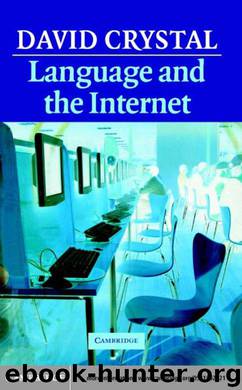David Crystal by Unknown

Author:Unknown
Language: eng
Format: epub
Tags: Internet linguistics
A common technique is to introduce a message with an explicit reference to a previous posting, usually in the form of a quotation from it or a paraphrase of it, as in these opening sentences:
(1) We're all democrats at heart? I don't think so.
(2) I never thought I'd hear someone talking about people power, not in 2000.
(3) >I was living in a different universe. [The writer has pasted this sentence from a previous message.] Isn't that the truth!
(4) Animated more, I'd say. [The writer is referring to a previous question: 'Are we animals?']
Lengthy quotation is unusual - indeed, unnecessary, because the previous messages are readily available in full. Little attention is paid to the accuracy of quotation, and quotation marks are unusual. It is the spirit rather than the letter of a message which is seen to be significant, and earlier phrasing can be adapted to suit the new
21 In this situation. An important difference between asynchronous and synchronous groups is that contributors to the latter do acknowledge the group in greetings and farewells. Indeed, it is considered bad form if they do not (pp. 154-5).
22 'Hello' sequences, often ludic, were a feature of the classroom sample studied by Gillen and Goddard (2000).
writer, as in the last example above. Even when contributions do not start in this way, the body of the message contains a significant re-use of salient individual lexical items. The term democrat, used in (1), resurfaced in several succeeding messages from different participants, until the conversation moved on. Extensive lexical repetition (in words and phrases) was found to be a major feature of the Davis and Brewer student conference, for example, suggesting that a useful way of identifying thematic threads (or topic shifts) in this kind of data will be to trace the use of individual lexical items and their sense relations (synonyms, antonyms, hyponyms, etc.). 23
From a pragmatic (as opposed to a semantic) point of view, what is interesting about a quotation is that it performs two roles. First, it conveys the illusion of adjacency, and thus makes the interaction more like the real conversational world. Second, it is another way of acknowledging group membership. In some respects, the explicit harking back to previous content performs some of the function of a greeting. Indeed, the strategy is common enough in face-to-face conversation, where we may hear people beginning a conversation by quoting something from their previous communicative encounters. An arrival at Holyhead railway station was met by someone whose opening remark was 'Who's never going to travel on Sundays ever again, then?' - the point being that it was a Sunday, and the person being met had evidently vowed, in those words, never to undergo that experience again. Then there was the following exchange, based on the participants' shared knowledge:
Colleague [introducing me]: This is David Crystal New contact: Ah, Language Death.
The reference was to my narrative not causative role in this topic, I am pleased to say, my book on that subject having recently appeared. In
Download
This site does not store any files on its server. We only index and link to content provided by other sites. Please contact the content providers to delete copyright contents if any and email us, we'll remove relevant links or contents immediately.
The Brazilian Economy since the Great Financial Crisis of 20072008 by Philip Arestis Carolina Troncoso Baltar & Daniela Magalhães Prates(117465)
International Integration of the Brazilian Economy by Elias C. Grivoyannis(87285)
The Art of Coaching by Elena Aguilar(52864)
Flexible Working by Dale Gemma;(23238)
How to Stop Living Paycheck to Paycheck by Avery Breyer(19613)
The Acquirer's Multiple: How the Billionaire Contrarians of Deep Value Beat the Market by Tobias Carlisle(12203)
Thinking, Fast and Slow by Kahneman Daniel(12004)
The Radium Girls by Kate Moore(11886)
The Art of Thinking Clearly by Rolf Dobelli(10166)
Hit Refresh by Satya Nadella(9010)
The Compound Effect by Darren Hardy(8758)
Tools of Titans by Timothy Ferriss(8176)
Atomic Habits: Tiny Changes, Remarkable Results by James Clear(8140)
Turbulence by E. J. Noyes(7913)
Change Your Questions, Change Your Life by Marilee Adams(7588)
A Court of Wings and Ruin by Sarah J. Maas(7587)
Nudge - Improving Decisions about Health, Wealth, and Happiness by Thaler Sunstein(7497)
How to Be a Bawse: A Guide to Conquering Life by Lilly Singh(7358)
Win Bigly by Scott Adams(7056)
